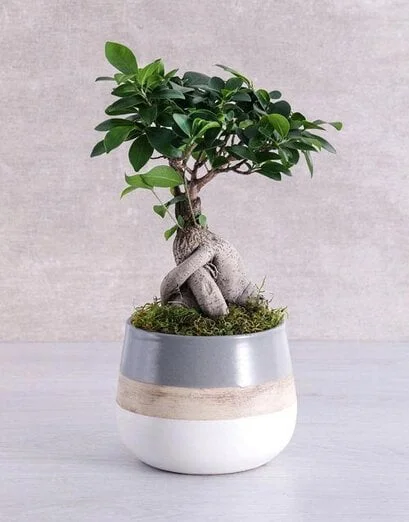🌿 The Complete Bonsai Tree Care Guide: From Beginner to Expert
Master the ancient art of bonsai with this comprehensive guide covering everything from basic care to advanced techniques. Whether you're a complete beginner or looking to refine your skills, this guide has everything you need.

🌱 What is Bonsai? Understanding the Art
Bonsai (盆栽) is the ancient Japanese art of growing miniature trees in containers. The word literally means "planted in a container" and represents a harmonious balance between nature, art, and human creativity. According to Bonsai Empire, this practice has been refined for over a thousand years.
Fun Fact!
Bonsai originated in China as "penjing" over 1000 years ago, then traveled to Japan where it evolved into the art form we know today!
Unlike regular potted plants, bonsai trees are trained through careful pruning, wiring, and styling to create the illusion of an ancient, weathered tree in nature. The goal isn't just to keep the tree small, but to create a living artwork that captures the essence and beauty of full-sized trees.
🎯 Key Bonsai Principles
- Miniaturization: Creating a tree that appears full-sized but in miniature
- Asymmetry: Natural, irregular balance rather than perfect symmetry
- Simplicity: Elegant restraint and avoiding unnecessary complexity
- Aged appearance: Techniques to make young trees look ancient

🏠 Getting Started with Your First Bonsai
Expert Tip from Sarah
"Start with a hardy species like Ficus or Juniper. They're forgiving and perfect for learning the basics before moving to more delicate varieties."
🌳 Best Beginner Species
🍃 Ficus (Fig Tree)
- ✅ Very forgiving with watering
- ✅ Tolerates indoor conditions
- ✅ Rapid growth for quick results
- ✅ Responds well to pruning
🌲 Juniper
- ✅ Classic bonsai appearance
- ✅ Extremely hardy
- ✅ Suitable for outdoors
- ✅ Many styling options
🌸 Chinese Elm
- ✅ Beautiful small leaves
- ✅ Adaptable to indoor/outdoor
- ✅ Quick to develop character
- ✅ Tolerates beginner mistakes

Perfect Starter Bonsai
This beautiful bonsai in a stylish striped pot is ideal for beginners. It comes with everything you need to start your bonsai journey!
💧 Mastering Bonsai Watering Techniques
Watering is arguably the most critical aspect of bonsai care. FTD's bonsai experts emphasize that because bonsai grow in shallow containers with limited soil, they dry out much faster than regular potted plants.
Critical Warning
Never let your bonsai soil completely dry out! This can kill your tree in just one day during hot weather.
🎯 The Finger Test Method
Bunnings gardening experts recommend the simple finger test: poke your finger 1cm into the soil. If it's dry below that point, it's time to water.
💧 Proper Watering Technique
- Use a watering can with a fine nozzle to avoid disturbing the soil
- Water slowly and thoroughly until water drains from the bottom holes
- Wait 5 minutes, then water again to ensure complete saturation
- Check daily but don't water on a schedule - check soil moisture instead

🗓️ Seasonal Watering Guide
🌸 Spring
Daily checking, water every 1-2 days as growth accelerates
☀️ Summer
Check twice daily, may need daily watering in heat
🍂 Autumn
Reduce frequency, water every 2-3 days as growth slows
❄️ Winter
Water sparingly, every 3-5 days depending on dormancy
☀️ Light Requirements: Indoor vs Outdoor Bonsai
🏠 Indoor Bonsai

- Need bright, indirect light for 6+ hours daily
- South-facing windows are ideal
- Rotate weekly for even growth
- Consider grow lights in winter
- Watch for leaf yellowing (too little light)
🌤️ Outdoor Bonsai

- Morning sun, afternoon shade is perfect
- Protect from harsh afternoon sun
- Provide wind protection
- Bring indoors during extreme weather
- Monitor for sun scorch on leaves
Pro Lighting Tip
Most bonsai prefer morning sun and afternoon shade. If leaves turn yellow or brown, they may be getting too much direct sunlight.
🌱 Soil Composition & Fertilizing Your Bonsai
🏺 The Perfect Bonsai Soil Mix
Unlike regular potting soil, bonsai soil must provide excellent drainage while retaining some moisture. Nebraska Bonsai experts recommend a mix that's 50% drainage material and 50% organic content.
🧪 Basic Bonsai Soil Recipe
- 40% Akadama (or similar clay granules)
- 30% Pumice
- 20% Lava rock
- 10% Organic compost
🌿 Fertilizing Schedule
Martha Stewart's gardening team recommends applying a complete liquid fertilizer at half strength every six weeks during the growing season.
Important Note
Never fertilize a dry bonsai or immediately after repotting. Always water before and after fertilizing!

📅 Monthly Fertilizing Calendar
Mar-May
Start fertilizing, every 2 weeks
Jun-Aug
Peak growing, weekly feeding
Sep-Nov
Reduce to every 3 weeks
Dec-Feb
Stop fertilizing during dormancy
✂️ Pruning & Shaping: Creating Your Masterpiece
🌿 Maintenance Pruning

- Remove dead, diseased, or damaged branches
- Pinch new growth to maintain shape
- Remove shoots growing straight up or down
- Thin crowded areas for better light penetration
🎨 Structural Pruning

- Remove large branches to create basic structure
- Best done during dormant season
- Cut back to 1/3 of branch length
- Seal large cuts with wound paste
Safety First!
Always use sharp, clean tools. Disinfect between trees to prevent disease spread. Start with small cuts - you can always remove more!
🛠️ Essential Pruning Tools
🏺 Repotting: Giving Your Bonsai Room to Grow
🕰️ When to Repot
Miyagi Bonsai specialists recommend repotting every 2-3 years for young trees, every 3-5 years for mature ones. Look for these signs:
- ✅ Roots growing through drainage holes
- ✅ Water runs off instead of soaking in
- ✅ Tree hasn't grown much despite good care
- ✅ Soil looks compacted or breaks down
📋 Step-by-Step Repotting Process
- Choose the right time: Early spring before buds open
- Remove from pot: Gently work tree out, don't force
- Trim roots: Remove 1/3 of root mass, focus on bottom and sides
- Prepare pot: Clean pot, add drainage mesh and wire
- Position tree: Place slightly off-center for better aesthetics
- Add soil: Work fresh soil around roots with chopstick
- Water thoroughly: Soak until water runs clear from bottom
- Protect: Keep in shade for 2-4 weeks to recover

Post-Repotting Care
Keep your newly repotted bonsai in shade, maintain consistent moisture, and avoid fertilizing for 4-6 weeks while roots recover.
🚨 Common Problems & Solutions
Leaves Turning Yellow
Possible Causes:
- Overwatering or underwatering
- Poor drainage
- Insufficient light
- Natural leaf drop (seasonal)
Solutions:
- ✅ Check soil moisture daily
- ✅ Improve drainage if needed
- ✅ Move to brighter location
- ✅ Remove yellow leaves promptly
Pest Infestations
Common Pests:
- Aphids (green/black clusters)
- Spider mites (tiny webs)
- Scale insects (hard bumps)
- Fungus gnats (small flying insects)
Treatment:
- ✅ Insecticidal soap spray
- ✅ Neem oil application
- ✅ Improve air circulation
- ✅ Quarantine affected trees
Branch Dieback
Why It Happens:
- Sudden environmental changes
- Root problems
- Disease or fungal issues
- Severe drought stress
Prevention:
- ✅ Gradual environmental changes
- ✅ Consistent care routine
- ✅ Good air circulation
- ✅ Regular health checks
🤔 Frequently Asked Questions
How long do bonsai trees live?
With proper care, bonsai can live for hundreds of years! Some famous bonsai are over 500 years old. The key is consistent, proper care and passing them down through generations.
Can I keep my bonsai indoors year-round?
Some species like Ficus can thrive indoors, but most bonsai prefer to spend time outdoors. If keeping indoors, ensure bright light and good air circulation.
How often should I wire my bonsai?
Wire when you need to reposition branches, typically during repotting. Remove wire after 3-6 months before it cuts into the bark. Young trees may need rewiring annually.
What's the biggest mistake beginners make?
Overwatering! Many beginners kill their bonsai with kindness. Always check soil moisture before watering and ensure good drainage.
How much should I expect to spend starting out?
A good starter bonsai with pot costs R 500-1000. Add R 300-500 for basic tools. Quality tools and advanced trees can cost much more, but start simple!
Do bonsai trees flower or fruit?
Yes! Many bonsai species flower and even produce fruit. Cherry, apple, and azalea bonsai are particularly spectacular when in bloom.
🎥 Watch: Expert Bonsai Tutorial
Learn from the masters with this highly-rated tutorial (2.8M+ views)
How to Make a Bonsai Tree
This comprehensive tutorial from Bonsai Empire shows you how to create a beautiful bonsai from nursery stock. Perfect for beginners looking to get hands-on experience!
Ready to Begin Your Bonsai Journey? 🌿
Join thousands of plant lovers who've discovered the peaceful art of bonsai. Browse our carefully selected collection to find your perfect starter tree.


